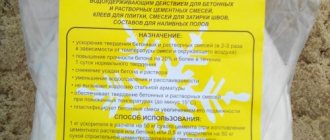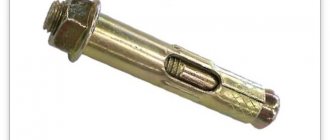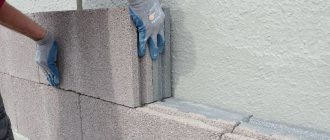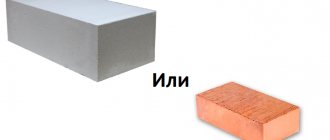The well-being of a private household, especially in humid areas, provides good drainage that removes excess water, including polluted water. The presence of wastewater, groundwater and storm water requires the installation of at least one drainage well for sewerage on the site, with the discharge or pumping of wastewater.
Drainage well as part of a septic tank Source optopg.ru
What are drainage wells for and what are they?
A private house or cottage is often located in an area prone to waterlogging; its foundations can gradually collapse under the influence of groundwater. Also, owners are often faced with the fact that there is no sewerage system, which means there is nowhere to put the water from the septic tank. There is a possible threat of flooding of residential and non-residential buildings, especially such as a cellar, garage, bathhouse, garden and vegetable garden. In these cases, a drainage well, and possibly an entire drainage system, is needed.
Collecting excess water in an underground container, by gravity or pumping, with constant or periodic removal - this is the meaning of a drainage well. The system is installed once and will work for the entire period of operation of the house. But during use, the drain well requires periodic cleaning. To do this, silt deposits are lifted from the bottom of a clogged well with a stream of water, followed by pumping or draining them.
The drainage well device can be of three types :
- Inspection (inspection) and drainage wells for sewerage, located at the places where drainage pipes turn and intersect or every 40-50 meters of drains, periodically clean them, and if there is no drainage, pump them out. To construct such wells, it is often enough to use a pipe with a diameter of 34 cm or more.
Inspection well at the intersection of drainage pipes Source rinnipool.ru
- Collectors (water intakes) are the final points for draining water, most often only surface water (storm water, melting water, stream water), with its pumping into a sewer system, reservoir, or use for household needs. They are characterized by a rather large volume, often an impenetrable bottom, and a built-in staircase is common for them. The placement of the pump and maintenance procedures impose restrictions on their diameter - at least 70 - 100 cm.
- Backfill (absorption, filtration) , they are located in places where they want to get rid of puddles, for example after washing cars. Around them it is planned to pour a large mass of rock, crushed stone, and screenings, both for supplying water to the well and for draining it through its bottom into deep water horizons. In particular, the bottom of the grouting well is covered with a layer of crushed stone 30 cm thick. In this device, partial bacterial and mechanical treatment of wastewater occurs, with periodic washing or mechanical extraction of silt and sand.
This is what the diagram of a filtration well looks like Source flotenk.ru
In cases of mixed type wells, their functions overlap, and the structure of the drainage well changes. Thus, a water intake well can discharge water into a grouting well. In this case, it does not require a sealed bottom and can do without a pump, but it still needs periodic inspection and cleaning, like an inspection well.
Start of work, preparation of the pit
To correctly calculate the width of the pit, it is necessary to add 30 centimeters to the diameter of the septic tank for subsequent sprinkling of this gap with crushed stone, gravel and coarse sintered slag (1.5-3 cm) along the entire perimeter of the outer walls. This sprinkling will act as drainage when discharging wastewater into the ground and is the main working area of the drainage well.
Then the bottom of the pit is covered with sand to a depth of 10-15 cm and filled with water so that the sand is compacted. The distance to the occurrence of groundwater from the bottom of the pit should be more than one meter; if more than two meters remains, then the filter load of the drainage well can be increased by 20%.
Manufacturing materials
The traditional material for the walls of drainage wells is reinforced concrete rings. Reinforced concrete is also used as a bottom material (a reinforced concrete disc is placed at the bottom of the hole, at the base of the future drainage well) and a cover (with a hole for a hatch). Reinforced concrete is quite cheap, strong, and durable.
However, the installation of ready-made reinforced concrete requires the use of lifting equipment or large labor costs; the joints formed during installation can be difficult to seal.
See also: Catalog of companies that specialize in installation and design of sewerage systems
Installation of reinforced concrete rings will not be possible without the use of special equipment Source gidroguru.com
These structures are usually installed by first digging a large pit. And after installing the first ring and installing asbestos, ceramic, cast iron or other heavy and fragile pipes, it is gradually covered with soil using bulldozers and excavators.
This is a rather expensive technology that disturbs the top layer of soil. Recently, wells made of plastic and composite materials are increasingly being used.
Some tips
- There is no need to spend money on waterproofing materials; they are not needed here. On the contrary, the better and more evenly the water flows out, the easier it is to use the system and clean it.
- The well cannot be installed in an area where there are problems with a high level of the ground aquifer. It is best to go even below the clay layers so that the effluent undergoes as thorough filtration as possible;
- A thin (200 mm) layer of coarse sand or sand-gravel mixture (small fraction) placed on the bottom of the well will help to avoid soil heaving, clean the wastewater as much as possible and achieve better absorption;
- Perforation of the walls must be done correctly: not lower than 500-800 mm from the bottom level, so that the water comes out evenly;
- To avoid silting of the perforation, it is necessary to cover the circumference of the barrel or ring with expanded clay and medium-fraction gravel;
- High-quality ventilation, waterproofing of the upper part of the drainage well, insulation of the top - all these requirements are mandatory for the uninterrupted functionality of the system. It would be correct to install a removable type cover on the structure in order to have access to the inside;
- Calculation of parameters, corresponding volumes of water discharge, determination of a location for a drainage well are the primary tasks that need to be resolved before the start of construction.
The consumable part of the structure is large, however, following the tips you can slightly reduce costs:
- The depth of the trench is equal to the modular size plus half a meter, the total depth of the pit is 2 meters. The bottom is lined with 500 mm of sand, then 300 mm of crushed stone, the cushion is compacted and only then the module is installed. The method will help to avoid the cost of geotextiles or other expensive filter materials;
- For non-silting of modules, you can use geotextiles (cover), or you can also use fine-grained expanded clay;
- After all, the system is covered with medium-fraction crushed stone, without sealing the holes for the ventilation pipes;
- All that remains is to add the layer to the soil level. You don’t need to take expensive compounds; just make a mixture of soil and sand. In some cases, a geogrid will be required.
Video description
About the installation of plastic drainage wells in the video:
Advantages of a plastic drainage well
Instead of massive reinforced concrete rings with steps and pipes in which a person can easily fit, composite and plastic thin-walled devices, including small diameter ones, are increasingly being used. In this case, you can immediately install a ready-made well on the site.
This approach allows you to quickly and cheaply equip and maintain the drainage of a private house, garage, or bathhouse.
Drainage wells made of plastic are distinguished by the fact that the installation of a drainage well, dismantling and reinstallation of the new system and light pipes leading to it (usually also plastic) can be done by one person without the involvement of special equipment and without serious disruption of the landscape.
Plastic wells will require fewer resources to install Source giropark.ru
Conclusion
Making your own drainage well is not at all difficult, so every home craftsman can handle this task. The main thing is to determine the most optimal location of structures, and decide where and what type of structures should be used. Otherwise, you just need to follow the above recommendations. (See also the article Sealant for concrete: features.)
You can get more information on this topic from the video in this article.
Installation sequence
How to install a drainage well:
- Pouring the concrete bottom of the well if its tightness is necessary.
- Installation of a composite or solid well.
- Laying and inserting inlet and outlet pipes.
- Arrangement of such parts as a ladder, cover, hatch, pump.
- Using a level, check the verticality of the well and the horizontal slopes of the pipes.
What tools and materials will workers need?
The main responsible and time-consuming work when installing a drainage well is making a tie-in and its subsequent sealing. In addition, it is necessary to dig holes and trenches, adjust pipes to length, adjust their slope to gravity, and adjust the depth and height of the well.
Based on this, a grinder (angle grinder) is required for work. If the material of the well is concrete or composite, asbestos and ceramic pipes are used, then the grinder requires diamond discs for concrete and a sledgehammer. If the well and pipes are plastic, metal discs and a hammer are enough. In addition, you definitely need a level, which can be supplemented with a plumb line, a level, as well as a tape measure, cord, shovels, trowel, and bucket. For digging narrow trenches, a convenient device is made from a piece of tin, twisted into the shape of a truncated cone and nailed to a stick.
Trenches for pipes and a hole for a well can be dug manually, but it is unlikely to cost less than calling an excavator Source deilo.ru
To seal the cut-ins and level the bottom, giving it the shape of pipe trays, use cement mortar, or, if dealing with plastic, use glue, plaster or tape, or sealant.
Advantages of prefabricated wells made of reinforced concrete products
When planning the construction of drainage systems, attention is paid to many parameters on which the reliable operation of utility networks depends. A drainage well made of reinforced concrete rings is superior to similar products made of brick, concrete, wood and plastic in almost all technical parameters.
Drainage wells assembled from reinforced concrete products have the following advantages and disadvantages:
- High strength. The products are resistant to extreme vertical and horizontal loads that arise due to seasonal soil movements.
- Design integrity. Tightness is achieved by special ledges on the edges of the rings and the use of reliable seals. In unstable soils, shaft fragments are connected by welding.
- Resistance to the influence of aggressive environments. Concrete is immune to acid and alkali, which are found in some types of soil. Plaque and silt do not corrode this material. They are not interested in insects and rodents.
- Fast construction time. When using an excavator, installation of the shaft takes only a few hours. At the same time, the quality of the finished structure is guaranteed.
- Long service life. This is a very valuable quality that is valued by private developers and large contractors, since repairing drainage systems is a fairly significant problem.
- Easy to maintain. It consists of periodically replacing the filter and cleaning the shaft walls of sediment and plaque.
The rings are made by vibration pressing using durable steel reinforcement. Thanks to this, there are no cavities or cracks in the finished products that could weaken the concreted well.
We should also dwell on the disadvantages of a prefabricated mine. These include the significant weight of the rings, which requires the rental of trucks and lifting equipment. This also implies the need to arrange access roads to the installation site. The weak point of a concrete shaft is the joints of the fragments from which it is assembled. Their strengthening affects the speed and cost of installation.
Where to place the drainage well
As for the inspection well, it is usually located a couple of meters from the lower (or conventionally lower) corner of a residential building, which is surrounded by drainage pipes. In such a well, most often there are three inserts for pipes: two drainage and one drain (this pipe can drain water into a sewer, a reservoir, into loose soil down a slope, or into a drainage well of another type). It can be very small, and then to check its condition it is enough to have a tiny removable hatch and a sludge dipstick (like a car one, which is used to measure the oil level).
A collector well is necessary if the soil is clayey and does not absorb water well. It is located a couple of meters from the lower (or conditionally lower) corner of the site or behind it, in cooperation with neighbors. They immediately provide for how to safely descend into the well in an emergency. Let's say it's raining, and a bag of garbage is stuck in the drain hole, what should you do? They also find out what useful volume the collector needs (practice shows that it is better to immediately take it with a reserve).
The volume of the collector well should not be small Source vi.decorexpro.com
A grouting well is usually installed after a septic tank, if there is no sewerage or other drainage area nearby, and the volume of discharge of household or cleaning waste is small (about 1 m³ per day). Concrete is practically unsuitable for such a structure - it is better to take composite, metal, or plastic. Before backfilling, such a well is lined with soft material, protecting it from damage by blocks of stones and rubble, and after backfilling it is perforated by drilling holes in the lower part from the inside.
What type of pump should be used to pump out drainage water?
A pump is a common attribute of all types of wells. To pump out drainage water, both stationary and periodically used pumps are used. For continuous operation, select a pump of small capacity but sufficient power, such as a submersible drainage or drainage float pump.
A powerful and efficient pump is used to periodically pump out silt and sand deposits. If a pump is used to pump out a pond, extract sand, or deepen the bottom of a port, it is probably suitable for getting rid of sediment from a drainage well.
A submersible pump for a well will help you easily pump out liquid from an overflowing container Source abad.uz
Pumps suitable for removing sediments are called differently: mud pump, submersible pump, fecal pump, centrifugal pump, sand pump, hydraulic pump - the question is not the principle of operation or name, but whether this device is intended for pumping out sediments, including silt, sand and even small pebbles.
In principle, any pump according to the technical passport “drainage” should pump out accumulated deposits, but for this it may not have enough power (say, the “Malysh” pump) or steam. Two pumps are usually used to remove deposits. Also, a container of about 200 - 300 liters may be required. The sequence of work is as follows:
- A mud pump pumps water out of a drainage well.
- A water-type pump supplies, as powerfully as possible, clean or settled water from a container or other source.
- A mud pump (for example, Pumpex SK series, Makita, Kärcher, Grandfoss), switched on when the water flow starts, pumps out the turbid water, carrying away sediments.
- Another option for cleaning sediments: a team scoops out sediments with buckets, trowels, and shovels by hand.
The manual cleaning method is the cheapest, but not the cleanest Source megapolis-tula.ru
In any case, drainage storage wells require maintenance using pumps (the water still needs to be pumped out before manual cleaning).
Stage four. We protect the structure from surface water
To keep your well clean, it must be properly protected. Water should enter the shaft only from below, and therefore the walls must be reliably insulated. To do this, we firmly connect the rings to each other, resorting to one of two possible methods.
Well
- We drill the walls of the rings and fix them with metal brackets mounted on bolts.
- We twist the rings with steel wire, catching it on the loading eyes. To twist the wire we use a metal rod, for example, a crowbar.
External and internal sealing of concrete rings with traditional bituminous materials
We strengthen the seams according to the following scheme.
Step 1. Place pieces of linen rope in the voids between the rings (an excellent material - natural and environmentally friendly).
Step 2. Cover the ropes with a solution of sand, cement and liquid glass. By doing this we will achieve reliable waterproofing, which will also be completely neutral when in contact with water.
Step 3. On top of the upper rings, dig a meter-deep pit.
Step 4. Waterproof the outer surface of the rings using liquid bitumen mastic.
Step 5. Place a thermal insulation layer around the upper rings (we can use any foamed polymer, for example, polystyrene foam).
Step 6. Fill the pit around the well with clay. This is called a "clay castle".
Clay well castleClay well castle











